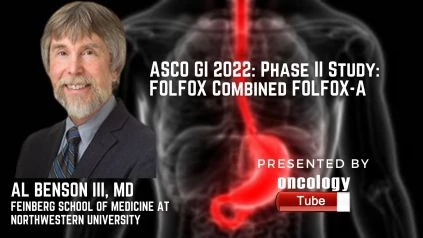Al Benson III, MD, Professor, Medicine, Hematology-Oncology Division; Feinberg School of Medicine at Northwestern University. In this video he speaks about the ASCO GI 2022 Abstract – A phase II study of FOLFOX combined with nab-paclitaxel (FOLFOX-A) in the treatment of metastatic or advanced unresectable gastric, gastroesophageal junction adenocarcinoma: Big Ten Cancer Research Consortium—BTCRC-GI15-015.
Origins:
The current standard of care for advanced gastric/GEJ cancer is doublet platinum or taxane-based treatments. Anthracycline-based triplets had already been abandoned due to a lack of efficacy and toxicity. We believe that combining FOLFOX with nab-paclitaxel (FOLFOX-A) will result in improved effectiveness, tolerability, and patient reported outcomes.
Methodologies:
In chemotherapy–naive unresectable, advanced gastric/GEJ adenocarcinoma, a phase II single arm trial of FOLFOX + nab-paclitaxel is being conducted. Every 14 days, Nab-paclitaxel 150 mg/m2, Oxaliplatin 85 mg/m2, Leucovorin 400 mg/m2, and 5-FU 2400 mg/m2 are given over 46-48 hours. The response rate was the primary goal. For solid tumors, evaluable disease according to RECIST v1.1 was required. Patients with Her-2 positive stomach tumors and clinically severe peripheral neuropathy were excluded from the study. The design was based on Simon’s (1989) ideal two-stage design. Clopper-Pearson confidence intervals and response rates are presented. The Kaplan-Meier technique was used to calculate progression-free (PFS) and overall (OS) survival.
Findings:
In Stage 1, a 29 percent response rate was observed, therefore the trial continued to enroll all 39 patients scheduled. The median age was 63 (range 20-80), and 29 (74%) of the patients were male. Thirty patients are no longer on treatment due to progression (17), alternative therapy initiation (5), and side effects (3). Treatment began for 38 patients. 14 (40.0 percent; 95 percent CI: 23.9 percent – 57.9%) of the 35 patients evaluated for response had CR/PR as the best response, with an 80.0 percent disease control rate. For 36 patients, progression-free (PFS) and overall survival (OS) data were available, with a median follow-up of 20 months (range: 1.9 – 34.45 months). The median PFS was 6.6 months (95 percent CI: 5.7–13.0), with 28.6 percent of patients surviving that long (95 percent CI: 15.2 percent – 53.9 percent ) PFS rate for a year. There were 21 deaths, with a median survival time of 11.0 months (95 percent confidence interval: 9.6–21.7), and a 46.6 percent 12-month survival rate (95 percent CI: 30.9 percent – 70.3 percent ). Peripheral sensory neuropathy, anemia (18.4% each), a lower neutrophil count (15.8%), and diarrhea were among the treatment-related grade 3–4 side effects (7.9 percent ). One patient died of multi-organ failure that was unrelated to the treatment. Due to toxicity, 23 patients required dose reductions or termination of at least one component of the three-drug regimen. Four cycles were completed on average (range: 0-30).
Outcomes:
Given the current approvals, FOLFOX-A has a significant response rate and predicted toxicity, and should be explored for future exploration in combination with immunotherapy.

